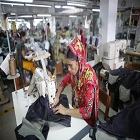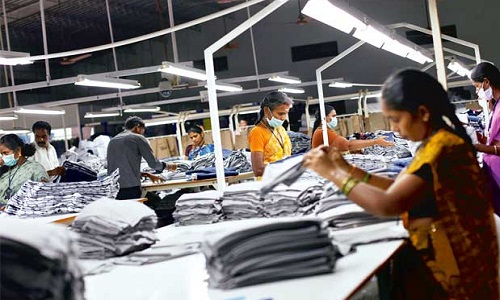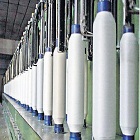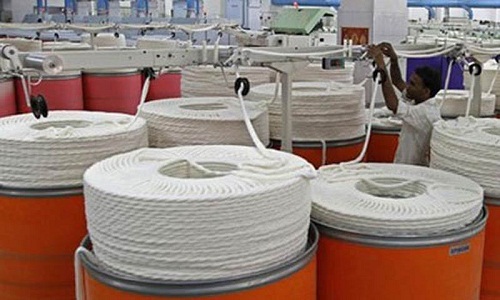FW
"Bangladesh has emerged an attractive destination for Indian RMG manufacturers. Many have set up units in the country simply because Bangladesh offers ease of doing business, importing-exporting is faster. R&D on new styles is faster as you can import fabrics in three days where as in India, it would take 10 days. In fact, the list of Indian companies setting up garment units in Bangladesh is long."

Bangladesh has emerged an attractive destination for Indian RMG manufacturers. Many have set up units in the country simply because Bangladesh offers ease of doing business, importing-exporting is faster. R&D on new styles is faster as you can import fabrics in three days where as in India, it would take 10 days. In fact, the list of Indian companies setting up garment units in Bangladesh is long.
Indian RMG exporters set up units in Bangladesh
Gurgaon-based and BSE-listed Pearl Global Industries set up a garment manufacturing unit in Bangladesh 12 years back. The company, which has 4,000 machines across four factories in the neighbouring country, is planning to double its capacity in the next three years. Chennai-based Ambattur Clothing has two units in Bangladesh which employ 8,000 people. It supplies clothes to brands such as Zara, Gap and Taylor. While the units in Bangladesh account for 60 per cent of the company's business, Chennai accounts for only 15 per cent.

So far, Orient Craft, a Delhi-based garment exporter which employs 32,000 people, stayed away from Bangladesh. Now, even Orient Craft is thinking of setting up a unit in Bangladesh. Say Indian exporters, as India's garment exports stagnate at $17 billion a year, Bangladesh's apparel exports are growing at double digits and are likely to touch $27 billion this year. India's garment exports were $15.49 billion between April and February 2015-16, up only 1.5 per cent over the corresponding period last year.
Bangladesh clocked $18.12 billion in apparel exports between July 2015 and February 2016, growing by 9.52 per cent over the corresponding period last year. For the past four months, its exports have been between $2.2 billion and $2.6 billion per month. The country overtook India in 2008 and its share of world trade began to climb from 2010 (4.19 per cent vs India's 3.16 per cent). Interestingly, India's share of the world trade in garments increased from 3 per cent in 2000 to 3.78 per cent in 2010. In 2014, India's share was 3.67 per cent while Bangladesh's share was 5.09 per cent, according to WTO data on clothing exports as of October 2015.
According to Sudhir Dhingra, Founder & Chairman, Orient Craft, the Indian government is not willing to do much (like bilateral trade deals with EU and others to drive competitiveness). “If we can't beat them, join them.” Vijay Mathur, Additional Secretary General, Apparel Export Promotion Council, points out exporters are shifting to Bangladesh as buyers want it that way. Bangladesh offers ease of doing business, importing-exporting is faster. R&D on new styles is faster as you can import fabrics in three days. In India, it would take 10 days. The more samples and styles you produce, the better the chances you stand to get an order. More than Indian exporters, it is Indian business families based in Sri Lanka and Hong Kong who have made the most of Bangladesh. These include Hong Kong-based groups like Must Garments, Epic Garments and Sri Lanka-based groups like Brandix, MAS Holdings and Hydramani Groups.
Advantage for Bangladesh exports
Bangladesh’s biggest advantage is duty-free exports to markets like the European Union, Japan, Australia and Canada under a preferential tariff system called Generalised System of Preferences (GSP), which provides an exemption from the more general rules of the WTO. Garment exports from India to Europe attract an import duty of 11-12 per cent.
Moreover, labour cost in Bangladesh is 25 per cent lower than India. A skilled worker in India, with two-hours of overtime, costs $200-$225 a month, while a similar worker in Bangladesh is available for $140-150 a month. Bangladesh’s labour is not just cheap, but also highly skilled - garment exports account for 82 per cent of Bangladesh's total exports.
In the past, power cost was 50 per cent lower than India due to abundance of gas, but that difference has come down. There's still some difference as boilers, generators and vehicles run on gas. Oil has come down to $40/barrel, but in India government is still increasing fuel prices, says an Indian exporter.
It's all about focus. In India, when you have consecutive holidays, like this week, the customs is closed. In Bangladesh, it is open 24x7 throughout the year. Even if you have strikes, vehicles ferrying garments enjoy exemptions, according to Dhingra. Also, provident fund or medical cover for workers is not statutory in Bangladesh. Working conditions are also poorer than India. A recent study by US brands found that only 24 of the 700 factories inspected met international safety standards.
Loss of opportunity for India
Owing to the duty disadvantage and higher costs, India became uncompetitive. It has vacated the mass-market for garments (shirts, trousers) and now largely plays in the fashion segment for value-added garments, like embroidery or in garments which need a lot of handwork, or premium garments that cost upwards of $15. Growth in garment industry can add a lot of jobs but exporters feel the government is oblivious to the opportunity.
One way to drive competitiveness is to go for bilateral agreements with key countries, seeking duty-free exports.
According to Dhingra, a bilateral agreement with European Union, which links foreign investment from EU to duty-free exports of garments from India, can grow exports to Europe 3-4 times to $24 billion-$26 billion in three years, from $9 billion today.
Pakistan’s textile export declined 8.16 per cent during the first nine months of the current fiscal year. Raw cotton exports recorded a decline of 47 per cent during the current fiscal year while cotton yarn fell by 32 per cent.
Export of raw cotton cloth declined by 10.14 per cent during the first nine months of the current fiscal year. Export of cotton carded or combed declined by 97 per cent during the first nine months. Knitwear exports declined by 2.10 per cent and bed wear exports fell by 4.13 per cent. Tents, canvas and tarpaulin exports decreased by 27 per cent in July to March 2015-16 as compared to July to March 2014-15. Art, silk and synthetic textile exports declined by 13.11 per cent during July to March 2015-16 against July to March 2014-15.
Made-up article exports registered a decline of 3.46 per cent during the current fiscal year. Exports of raw cotton declined by 66.68 per cent in March 2016 compared to the same month of the last fiscal year. Cotton yarn exports in March 2016 fell by 29.16 percent compared to March 2015. Cotton cloth exports fell by 5.52 per cent, cotton carded or combed export by 61.54 per cent, and exports of yarn other than cotton yarn by 8.66 per cent. Exports of towels fell by 6.51 per cent, art, silk and synthetic textile exports by 17.74 per cent, made-up articles by 1.11 per cent.
The Indian textile industry has been facing a long-drawn recession since April 2014. To enhance the industry’s competitiveness, the two per cent MEIS (Merchandise Exports from India Scheme) benefit has been extended for all textile products other than cotton yarn.
The TUF scheme has been extended for the entire 13th five-year plan period. A sum of Rs 17,822 crores has been allotted to meet the committed liabilities of the schemes in the pipeline as also the ongoing and new schemes.
Under the amended TUF scheme, the spinning sector has been excluded while a 15 per cent capital subsidy has been extended for garments and technical textiles and a 10 per cent subsidy for weaving and processing sectors. Interest subsidies ranging from two per cent to six per cent extended under the earlier scheme have been discontinued.
As TUF subsidy refunds have been pending for more than one and a half years, the working capital has been totally eroded and most spinning mills are incurring cash losses due to the glut in the market. The industry has been hit by the global economic slowdown. Major markets have imposed a higher tariff on Indian textile and clothing products than they have on imports from competing nations like Pakistan, Bangladesh, Vietnam, Turkey and Cambodia.
Primark the European fast fashion retailer that offers men’s, women’s, kids’, home, beauty, active wear has seen a rise in revenues. Primark’s adjusted operating profit fell one per cent in constant currencies for the 24 weeks to February 27compared with the previous year, and three percent at actual currency rates, as the dollar strengthened against the euro. Sales were up seven per cent in constant currency on 2015, driven by increased retail selling space. Revenues rose five per cent but operating profit was down three per cent.
Primark had a few tens of millions fewer units of products across the entire group, compared to the same period last year. Its responsive supply chain is key to riding out unpredictable weather patterns and shifts in customer behavior. The chain has managed well with the inventory it had in January and February. It has kept a close eye on how sales were developing last autumn and reduced its buying volumes which ultimately led to less markdown in January and February. That has shown in its bottom line.
Primark's sales were hit by warm weather over the Christmas period. Profits at the chain were affected by currency movements. However the brand plans to open six more stores in the US this year.
Ethical Movement Fashion Revolution published its inaugural Fashion Transparency Index as part of the launch of the Fashion Revolution Week recently. Developed in conjunction with Ethical Consumer, the research includes 40 of the biggest fashion brands and ranks them according to the level of transparency in their supply chain.
Levi Strauss & Co, with brands Levi’s, Dockers, Signature and Denizen was ranked the most transparent fashion company with a 77 per cent score. It was followed by Inditex (76 per cent), H&M (76 per cent), Adidas (69 per cent) and Primark (67 p0er cent), while the worse rated brands included Chanel (10 per cent), Hermes (17 per cent), Claire’s Accessories (17 per cent) Forever21 (19 per cent), Fendi (19 per cent) and LVMH (19 per cent).
The research also revealed that 40 per cent of companies do not have a system in place to monitor compliance with labour standards and that only 11 companies show evidence of working with trade unions, civil society or NGOs on the ground in supplier countries to improve working conditions.
Stakeholders from Bangladesh’s leading ready-made garments manufacturers and exporters associations have called upon the National Board of Revenue (NBR) to reduce tax at the source at 0.30 per cent from the existing 0.60 per cent on export. They also urged NBR to consider it as final settlement from the budget for fiscal year 2016-2017.
Bangladesh Garment Manufacturers and Exporters Association (BGMEA) representatives, Bangladesh Knitwear Manufacturing and Exporters Association (BKMEA), and Bangladesh Garments Accessories and Packaging Manufacturers and Exporters Association have made the call at a premium budget meeting with NBR at its headquarters recently.
In the meeting, BGMEA President Siddikur Rahman urged NBR to implement the decision at least for the next three years to help the RMG sector by giving breathing time to the facility after the Rana Plaza disaster. The BGMEA head also recommended the NBR continue paying income tax at a minimised rate of 10 per cent for the next five years.
The other demands from the apparel makers include duty-free import of fire prevention machinery for a compliant industry, withdrawal of VAT from purchases made through local letter of credit, withdrawal of VAT, customs duty and advance income tax from the import of all machineries to help build compliant industries.
At the recently concluded Kingpins Amsterdam, Invista, global producer of polymers and fibers, has launched two new Thermolite brands, both to be worn in cold weather conditions and aimed at the jeanswear market. They introduced the Thermolite Infrared technology and patented the Thermolite Dual Layer technology as part of a new brand category called Thermolite Pro.
Explained Jean Hegedus, Global Segment Director for Denim at Invista that after conducting a consumer research by ICM Research in January 2016 Invista recognized how more than 70 per cent of respondents were interested in the concept of a winter jean. The Thermolite brand was the most preferred option in terms of a technology name that would generate consumer interest in purchasing such a garment. The two Thermolite Infrared and Dual layer technologies can be used independently or in tandem for enhanced warming and insulating properties.
The patented Thermolite Dual Layer’s structure can create open spaces within the fabric, trapping air to help keep the wearer warm. According to Invista’s testing, a fabric’s ability to insulate is measured by its CLO value, and fabrics with Thermolite Dual Layer’s technology can achieve CLO values that are typically 25 per cent to 30 per cent higher compared to those of standard denim fabrics. The Thermolite Dual Layer technology is also engineered to enable faster drying next to the skin, helping the wearer stay warm and dry.
According to the Competition Commission of India (CCI) interim order, Indian seed companies that use global agriculture firm Monsanto's technology will not need to destroy Bt cotton seeds, patent lines and germ plasm once their contract ends. The domestic companies had filed an anti-competition case against Monsanto for the inclusion of such causes in the license agreement these have with the global giant.
If the seeds, parent-lines and germ plasm, containing the technology of Monsanto are destroyed according to the post-termination obligations, it may not be possible for the Indian seed companies to restore the same at a later point of time. Thus, such destruction would cause irreparable and irretrievable harm to the latter and needs to be prevented, said CCI in its order.
This order would be applicable only after it is approved by the Delhi High Court. However, the CCI prevented the Indian companies from selling any seeds manufactured using Monsanto technology after November 30, 2015. The companies have also been asked to keep a proper record of these seeds. As per Article 9 of the sub-license agreements with Monsanto, whenever the agreement is terminated, the Indian seed companies have to immediately cease selling or distributing the seeds, destroy all the seeds, destroy the parent lines or other cotton germ plasm.
Earlier, Monsanto had terminated the sub-license agreements with three Indian companies - Nuziveedu Seeds, Prabhat Agri Biotech and Pravardhan Seeds - on 14 November last year. After filing an anti-competition complaint on 15 December last year, the Indian seed companies moved an application on 22 December asking interim relief.
"Indian Spinners Association (ISA) are opposing the continuation of anti-dumping duties (ADD) on viscose staple fiber (VSF) citing that it will have a negative effect on the textile sector in India, which is reeling under high cost of production and sagging export demand."

Indian Spinners Association (ISA) are opposing the continuation of anti-dumping duties (ADD) on viscose staple fiber (VSF) citing that it will have a negative effect on the textile sector in India, which is reeling under high cost of production and sagging export demand. The spinners’ body’s firm stand, which is a major segment of the Indian textile chain, assumes importance in the backdrop of Directorate General of Anti-Dumping & Allied Duties (DGAD) initiating a sunset review investigation for assessing the need for continuation of anti-dumping duties on viscose staple fiber excluding bamboo fiber from Indonesia & China.
Fair competition need of hour

Incidentally, VSF is one of the major inputs for manufacturing of man-made fiber yarn in India and is mostly used for the manufacture of fabrics made of poly-viscose (PV yarn) and 100 per cent viscose yarn. Aggrieved by the unwarranted tariffs and undue protection to the sole producer of VSF in India - Grasim Industries, the spinners have made representations to the Ministries of Textiles, Commerce & Industry and Central Board of Excise and Customs for removal of ADD to ensure fair competition and to make available the viscose at international prices in India.
Industry leaders, in their interfaces with concerned officials focused on the deteriorating health of Indian textile industry characterized by widespread sickness, uncompetitive and predatory VSF pricing policy of the Grasim, absence of ‘injury’ factor for the domestic manufacturer, a necessary condition for imposing ADD, impact of the unwarranted duty on input cost escalation, exports of yarn, fabrics, made ups etc.
S K Khandelia, President ISA, the petitioner points out that as the sole producer of VSF in India - Grasim Industries - using its oligopolistic position, has been charging the Indian consumers a higher price as compared to the international prices of viscose, consistently for the past six years, under the cover of ADD. “The domestic prices are artificially kept higher by Grasim to the tune of 20 per cent of international prices, which is higher than the alleged under-cutting margin. While Grasim exports at prevailing international prices, it leveraged its monopoly and anti-dumping coverage to charge higher prices from domestic customers, leading to dual pricing system in India,” he added.
Increasing imports of viscose
While Grasim has been charging a premium on sale of VSF from domestic spinning industry, the user industry (spinning industry) has not derived any benefit during the period of ‘injury.’ Therefore, ADD has led to extending unwarranted protection and subsequent enrichment of the manufacturer at the cost of the entire textile sector (user industry), which is the highest employment provider in India. The decline in the volume of yarn sales and employment in the textile sector is attributable to increasing imports of viscose yarn and fabrics from other countries, like China, Vietnam and other ASEAN countries, leading to large outgo of precious foreign exchange.
Echoing these views, M L Jhunjhunwala, Vice President ISA, said “The imposition of ADD is being used by the domestic VSF manufacturing industry as a shield to cover its inefficiencies and inadequacies in a competitive environment. The Competition Commission has already found Grasim guilty of controlling prices and pursuing differential pricing. Discontinuance of ADD will force Grasim to become more efficient, price competitive and achieve economies of scale. It will also boost export of viscose yarn, blended yarns and fabrics manufactured in India,” he said, adding that these steps will give a critical push to ‘Make in India’ mission of the government of India. The spinning industry, being the largest industrial employer in the country, will boost multi fold development across the country if it is able to source raw materials in a more competitive manner, he pointed out.
Sunil Bhargava, Founding Partner S Bhargava Associates and advisor to ISA on ADD matters points out, “Grasim being the sole manufacturer of VSF in India is claiming to be injured by the imports at alleged lower prices, whereas their balance sheet shows losses due to mounting debt servicing cost on expansions and higher fixed overheads in Nagda unit. Water shortage is another cause of production Slippages. As per the anti-dumping rules in India, there needs to be a clear causal relationship between the injury caused to the domestic industry and the dumped imports, if any. Therefore, before reaching a conclusion, the DGAD must objectively examine all factors establishing a causal relationship before arriving at an informed decision.”
Once the ADD on VSF is lifted, the VSF prices being charged by Grasim from the domestic consumers will be aligned to the international prices. This will reduce the cost of manufacturing of the Indian textiles, leading to higher employment generation and increase in export of value added textile products.
Consumers want fashion clothing brands in advanced countries to disclose how the garments are being produced in countries like Bangladesh, who is producing the garments, and the circumstances in which they are produced. In fact, consumers are ready to pay more to ensure the safety of garment workers.
The garment industry employs more than 40 million people in Asia Pacific. Only some companies have knowledge of their complex supply chain. And when they don’t know their supply chains, there is a high chance workers are exposed to exploitation and sweatshop conditions.
There are workers in Bangladesh readymade garment factories who earn above the minimum wage but still low enough to make life a struggle. A lot of pressure is placed on workers. They are under big pressure to meet targets. Sometimes one person is made to do the work of two people. They may not even have the time to get a drink of water because of the workload.
Companies are being urged to do more, to be more transparent, to disclose the nature of their supply chains, and to ensure workers are protected. Three years after the Rana Plaza disaster in Bangladesh, there are still safety concerns for garment workers as the majority of factories are yet to meet safety standards.












